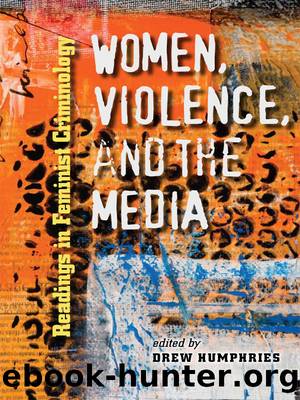Women, Violence, and the Media by Humphries Drew;

Author:Humphries, Drew;
Language: eng
Format: epub
Publisher: Northeastern University Press
CHAPTER 6
RAPIST FREED, VICTIM PUNISHED
Newspaper Accounts of Violence against Women in Bangladesh
Mahfuzul I. Khondaker and Melissa H. Barlow
Media representations are an important subfield in criminology, but rarely have Western social scientists considered the ways in which non-Western media socially construct violence against women. In an effort to remedy this deficiency, we focus on Bangladesh and on Southeast Asian perspectives on women, violence, and the media. In Bangladesh, violence against women is attributed to Purdah, a rigidly conservative form of patriarchy that excludes Bangladeshi women from public roles and subordinates them to men. Violence is exacerbated by political instabilities that stem from corruption, failures in security, and factionalized elites. Under these conditions, the independent press serves to witness social problemsâviolence against women, corruption, repression of opposition, and persecution of minoritiesâthat ruling parties would suppress. We believe that an analysis of Bangladeshi news promises to expand the thinking of Western readers about violence against women and its representations in the news.
The exploration is organized into several sections. We provide background about violence against women, the criminal justice response, Purdah, and the role of journalists in Bangladesh. Next, we lay out our research and describe our findings based on a sample of news articles taken from the on-line edition of the Daily Star, an independent, English-language paper published daily in Bangladesh. Our discussion of dowry killings, rape, and, among other things, abductions, returns to the issues of Purdah, political repression, political instabilities, and the role of an independent press.
Background
In Bangladesh, domestic violence occurs at higher rates and is more severe than in many parts of the world (Garcia-Moreno et al. 2006). This is the conclusion of a ten-nation survey sponsored by the World Health Organization. The survey looked at domestic violence in both cities and provincial sites. The lifetime prevalence of physical partner violence is 42% (Bangladesh provincial site), a high-end figure in a range where most sites fall between 23% (Thailand city) and 49% (Ethiopian provincial) (Garcia-Moreno et al. 2006, Table 4). Moreover, just under one-half of the women who had ever been victimized characterized the physical violence as severe. Severe violence includes being hit with a fist or other object; being dragged, kicked, or beaten up; being intentionally choked or burned; and facing a perpetrator who threatened to use or used a gun, knife, or other weapon. The lifetime prevalence for severe physical violence is almost half, which places Bangladeshi figures at the highest end of a range running from 4% (Japanese city) to 49% (Peruvian province) (Garcia-Moreno et al. 2006, Fig. 1). In Bangladesh, as elsewhere, severe domestic violence is part of a continuing pattern of abuse.
Women in Bangladesh, however, rarely disclose domestic violence (Navel, 2006; Rosenberg, 2006). In one survey of rural women, 66% of abused women never discussed their victimization with anyone (Rosenberg, 2006). They remained silent for several reasons. Women believed that their husbands had a right to use violence against them, they wanted to avoid the stigma of being an abused wife, or they feared greater harm by talking about what happened to them (Rosenberg, 2006).
Download
This site does not store any files on its server. We only index and link to content provided by other sites. Please contact the content providers to delete copyright contents if any and email us, we'll remove relevant links or contents immediately.
The Secret History by Donna Tartt(18188)
The Social Justice Warrior Handbook by Lisa De Pasquale(11957)
Thirteen Reasons Why by Jay Asher(8461)
This Is How You Lose Her by Junot Diaz(6452)
Weapons of Math Destruction by Cathy O'Neil(5842)
Zero to One by Peter Thiel(5498)
Beartown by Fredrik Backman(5369)
The Myth of the Strong Leader by Archie Brown(5243)
The Fire Next Time by James Baldwin(5024)
How Democracies Die by Steven Levitsky & Daniel Ziblatt(4966)
Promise Me, Dad by Joe Biden(4912)
Stone's Rules by Roger Stone(4867)
100 Deadly Skills by Clint Emerson(4695)
A Higher Loyalty: Truth, Lies, and Leadership by James Comey(4557)
Rise and Kill First by Ronen Bergman(4548)
Secrecy World by Jake Bernstein(4394)
The David Icke Guide to the Global Conspiracy (and how to end it) by David Icke(4386)
The Farm by Tom Rob Smith(4329)
The Doomsday Machine by Daniel Ellsberg(4250)
